Site menu:

September 2010 Newsletter
NW Estuaries - Redshank and Black-tailed Godwits.
August Bird News.
Forthcoming Events.
Moore NR Appeal.
Latest Newsletter.
North-west Estuaries - Part 3 Redshank and Black-tailed Godwit
This article follows on from the one published in the April 2010 Newsletter which discussed the status of Teal, Pintail and Shelduck in the estuaries of the 'North-west', and Part 2 which discussed the same for Knot and Dunlin in the July 2010 Newsletter. Please read the first three paragraphs of that first article for further information and caveats. In particular I repeat here that the analysis and treatment of the data is solely my own, and any mistakes are my own. The data used in the graphs is based on that from the Wetland Bird Survey (WeBS). Note that in the graphs MBS stands for Morecambe Bay South, i.e. that part of the Bay which is in Lancashire.
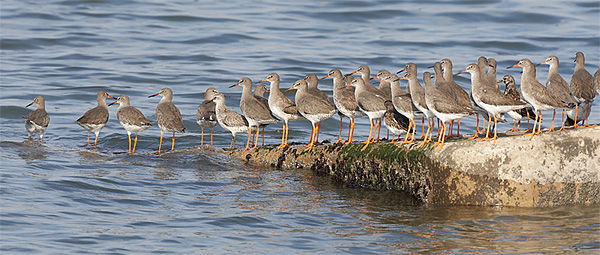
Redshank
Birds from five different populations of Redshank (Tringa totanus) can be found in the UK, although the vast majority in the North-west are robusta and britannica. The former breed mainly in Iceland and the Faeroes, and the latter in the UK. Numbers of robusta are thought to be stable, perhaps increasing, and britannica decreasing. Total wintering numbers of Redshank in this country showed an increase between the early 1980s until about 2000 since when they have decreased.

The Dee Estuary is the premier site in the country for this species with peak numbers occurring during the return migration (August to October), although in some years the Humber Estuary has similar numbers on passage as are recorded on the the Dee. Max numbers on the Mersey tend to be more variable, but have shown a marked decline since the winter of 2003/04. Morecambe Bay as a whole (as opposed to just MBS) has consistently been the most important wintering area (i.e. from November to March) for several years with max numbers around 7,000. MBS has about two thirds of these, the winter of 2008/09 being an exception. The Ribble Estuary has smaller numbers of around 3,000.

The graph below neatly shows the importance of the Dee Estuary for birds returning from breeding, and also to a lesser extent during the spring migration. The peak in April almost certainly consists mainly of Icelandic birds, these don't lay their eggs until mid-May whereas British breeders will all be on their breeding grounds by late March, laying in early April. The peak in September is also mainly of Icelandic birds as most British birds will have returned to the coast much earlier, in July. Ringing work by the Merseyside Ringing Group confirms that the vast majority of birds here are of Icelandic stock. Note that the other three estuaries show a peak in October, possibly these are birds dispersing away from the two important late summer sites - the Dee and the Humber.
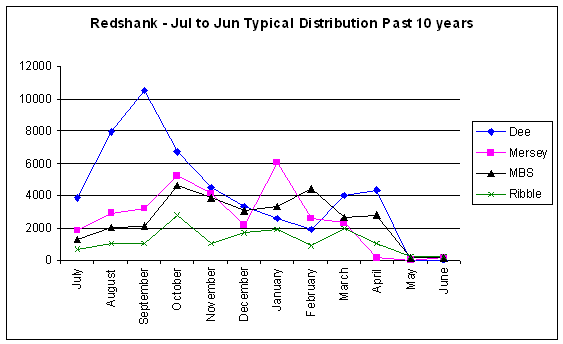
It is interesting to note that a study of the literature shows a marked difference between estimated total breeding birds for robusta and britannica and the total counted during winter - the former being at least double the latter. Maybe breeding populations are being over estimated, but it is also an indication that this species is thinly spread right round the coast, and inland, with many birds presumably missed during WeBS counts.
Black-tailed Godwit
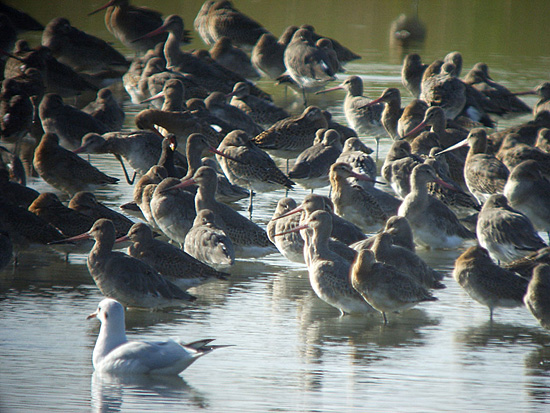
Apart from one or two pairs breeding in Lancashire all the birds in the North-west are of the islandica race which breed in Iceland. This sub-species has shown a sharp increase nationally since the early 1980s, and the increase has been even more dramatic in the North-west. In the winter of 1991/92 max numbers were just 1,617 for the Dee, 278 for the Mersey, 561 on the Ribble and 52 for the whole of Morecambe Bay! Compare this with the typical numbers currently present shown in the graph below. However, both nationally and locally there appears to have been a stabilisation in numbers over the past four years.
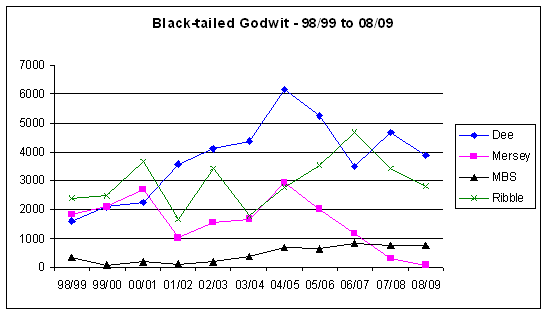
After the steep rise of counts on the Dee Estuary to the
max in 2004/05 numbers have now stabilised around the 4,000 mark - making
the site the third most important in the country. The Mersey Estuary has
shown a steep decline in numbers since 2004/05. The Ribble Estuary is
another important site for this species, they particularly like the
freshwater Marshside RSPB reserve near Southport, although numbers can vary
greatly here from day to day. For example the max count here in March 2007
was 6,000, yet that same month the WeBS count for the whole of the Ribble
Estuary (which includes Marshside) was just 218. The birds were there
just a few days before moving on. This is typical behaviour for this
sociable species which tend to move around in large flocks. We get a good
idea of these movements from colour ringing (see
December 2008 newsletter) and from
this we know there is much inter-change of birds between these estuaries. A
good example is of a bird seen at Gilroy Nature Reserve, West Kirby, on the
morning of Oct 8th 2008 which was recorded at Leighton Moss RSPB (Morecambe
Bay) later that day, only to return to Gilroy a week later. Sometimes we
note an absence of birds on the Dee Estuary only to be told later that many
of our
regular ringed birds were at Marshside, they then return to the Dee a few
days later.
Numbers on Morecambe Bay are present in relatively small numbers but show a
steady increase between 2001/02 to 2006/07.
You will notice I haven't drawn up a 'typical' Jul to Jun distribution graph for Black-tailed Godwits. That is because I couldn't find a typical distribution - numbers vary so much month by month and from year to year!
WeBS (Wetland Bird Survey) data in this article should not be used elsewhere in any way without permission of the WeBS Office. To access official WeBS data please contact the WeBS Secretariat - BTO, The Nunnery, Thetford, Norfolk IP 24 2 PU www.bto.org.
Sources of Information:
1. Cheshire and Wirral Bird Reports: 1998 to 2008.
2. Lancashire Bird Reports: 1998 to 2008.
3. Waterbirds in the UK (WeBS Report), reports from 1995/96 to 2007/08.
4. Neil Friswell and Colin Wells, Dee Estuary WeBS Annual Report,
2008/2009.
5. Simon Delany et al., An Atlas of Wader Populations in Africa and
Western Eurasia, Wetlands International, 2009.
6. W.G. Hale, Waders, New Naturalist, Collins, 1980.
7. Birds in Cheshire and Wirral (CAWOS Atlas), David Norman, 2008.
August Bird News
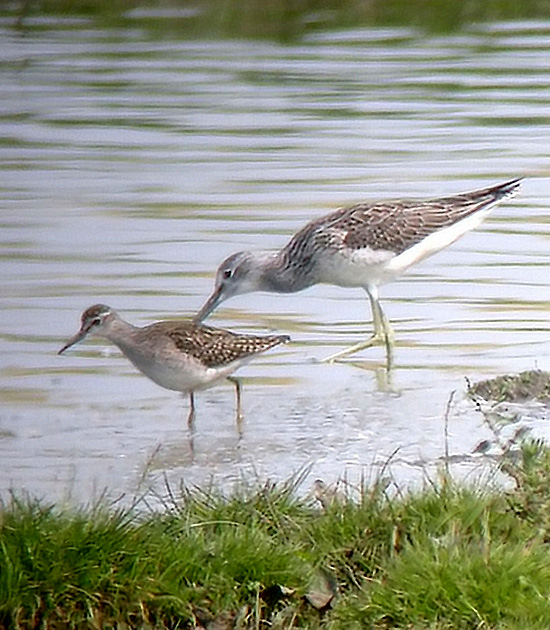
The Lesser Yellowlegs which was at Inner Marsh Farm at the end of July stayed until the end of the first week of August. We then had another rare American wader at the end of the month with a summer plumaged Long-billed Dowitcher which was at Inner Marsh Farm on the 26th and Connah's Quay on the 28th. A Wood Sandpiper was on the flooded field by Gilroy Nature Park, West Kirby, from 15th to 20th, and there was also Green and Common Sandpipers here on several dates. Three Green Sandpiper were at Shotton on 23rd. There were plenty of Greenshank around including eight on Hilbre on 15th; max numbers were 30 at Connah's Quay on the 5th and 29 at Parkgate on 26th. There have been several Spotted Redshanks at Parkgate in the past few weeks including five on 26th, a welcome return to a site which used to be a stronghold for this species. A Curlew Sandpiper was at Hilbre on the last day of the month.
It has been fascinating watching the build up of Black-tailed Godwits at Gilroy Nature Park as they return from Iceland, numbers increased virtually every day of the month starting with 27 on the 5th and finishing with a site record of 800 by the end of the month. There was just one juvenile in that first flock but these rapidly built up to 50% of the flock by the time they reached 400; towards the end of the month there was an influx of adults and the percentage of juveniles went down to 36%. Four of these godwits were colour-ringed and the story of these birds, and other colour- ringed birds we've seen over the past two or three years, will be the subject of a future newsletter article.
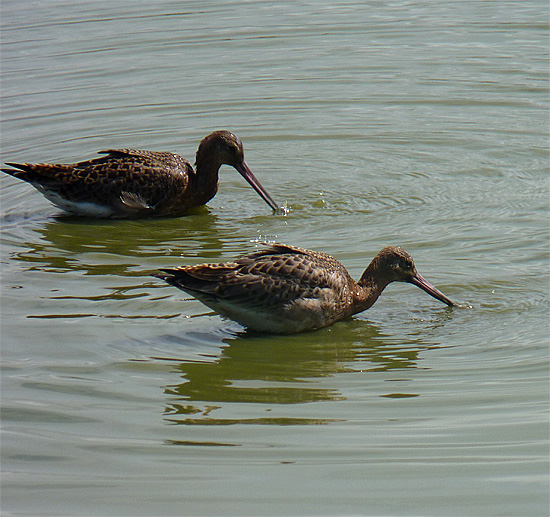
As usual for August sea-watching was good. A juvenile Black Tern gave good views from Hilbre for several days early in the month. There were quite a few Skuas around including six Arctic and a Great during windy weather on 24th, and more windy weather brought in a Long-tailed Skua on 29th. There were few Manx Shearwaters around until 20th when a feeding flock of 750 were seen from Hilbre. Just one Storm Petrel was recorded - from Hoylake Shore on 24th. Numbers of Sandwich Tern peaked at 850 on the 10th.
During a warm sunny day on the 25th (in between days of strong wind) there appeared to be something of a fall of Wheatears with 12 at Hoylake, seven at Leasowe, nine on Little Eye and 'lots' at Heswall. On the 30th there were 12 Greenland Wheatears on Hilbre, during a lovely sunny day.
There were several reports of Marsh Harriers on passage, and at least one Hen Harrier (ringtail) and a couple of Short-eared Owls have returned. An Osprey flew S over West Kirby on 16th and another over north Wirral on 19th.
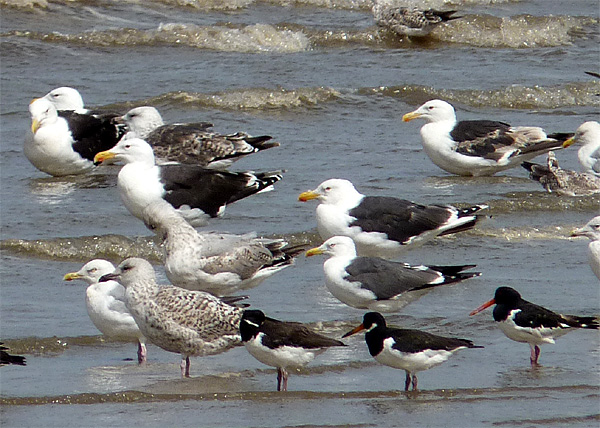
several Great Black-backed Gulls, August 11th, © Richard Smith.
Richard Smith.
What to expect in September
September is often excellent for sea watching but last year was exceptional with Sabine Gulls, Balearic Shearwaters and Sooty Shearwaters - not to mention a Wilson's Storm Petrel! Can we expect the same this year? That would be too much to expect - but prolonged north-west gales will bring in plenty of good birds, and we are overdue a good Leach's Petrel year. If we get gales for two days or more then we could get 100 or more Leach's Petrel trapped in the mouth of the Mersey then slowly making their way along north Wirral, Hilbre and Point of Ayr - given the right weather conditions this is the best place in the country to see these fantastic birds .
Some years September can be disappointingly calm but that can mean it will be good for Curlew Sandpipers, these lovely waders, looking like attenuated Dunlin, can turn up just about anywhere on the estuary - although Heswall is the most reliable place for them. There will be plenty of Greenshank at Parkgate, Inner Marsh Farm and Connah's Quay. These same sites should also have plenty of Black-tailed Godwits, see if you can pick out the juvenile birds from the adults. Gilroy Nature Park at West Kirby can hold several hundred of this species at this time of year.
Rarities are a distinct possibility, last year we had two Long-billed Dowitchers, a Citrine Wagtail and Greenish Warbler, and the year before a White-winged Black Tern. Harriers and Short-eared Owls should be back on the marshes, and there are usually one or two Spoonbills around.
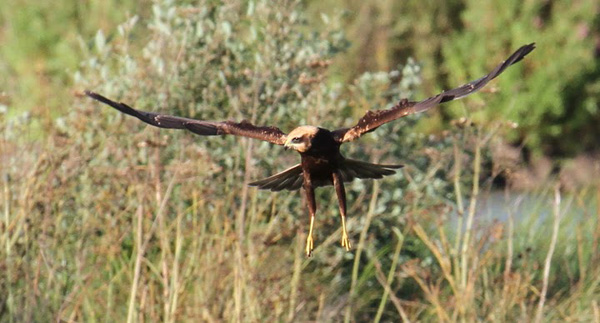
HELP NEEDED - MOORE NR
A model aircraft club has put in a planning application to set up a fly zone
over part of the reserve and Upper Moss Side. Please object!!! This can be done
online and takes only a few minutes - see
www.moorepatcher.blogspot.com
for links etc.
Forthcoming Events
September Highest Spring Tides (Liverpool)
Also see
Tides page.
9th September, 12.23hrs (BST), 9.9m.
10th September, 13.05hrs (BST), 9.9m.
11th September, 13.46hrs (BST), 9.8m.
Forthcoming Events
Organised by the
Wirral Ranger Service ,
Flintshire Countryside Service and/or the RSPB:
Thursday
9th September, 9am start, Mud 'n' Marsh -
Heswall Shore.
Friday 24th September, 7pm until late, Burton Mere Bat Night. Saturday 25th September Saturday 9th October - 9:30am start,
Birdwatch at King's Gap, Hoylake. Monday 11th October, 11am start, Godwit Spectacular. Friday 22nd
October – 9:30 am till 12:30 pm, Waders at West Kirby.
All these events and walks have bird interest, even those not advertised
specifically for birdwatching. No need to book for these events unless
specified - please check below.
Also see 'Wingspan', a Diary of Birdwatching
Events for Wirral and the North Wales Coast.
Join the Rangers and members of the WCP Recording Group on Heswall Shore to
catch the first of the returning winter visitors to the Dee mudflats.
Redshank and Shelduck numbers will be rising and there’s always the chance
of a scarce passage migrant or two popping up!
No need to book, meet at Banks Road car park, Lower Heswall.
For further enquiries please telephone 0151 648 4371.
The RSPB and The
Cheshire Bat Group are joining forces to bring you a unique opportunity
to find out about the fascinating flying mammals that live around the
reserve at Inner Marsh Farm and beyond. Booking is essential, places are
limited. £3 RSPB/Bat Group members, £5 non-members - includes guided walk
around Burton Mere and use of bat detectors. Call 0151 336 7681 to book and
for further details - includes guided walk around Burton Mere and use of
bat detectors.
A free guided walk around the newly acquired grounds at the site of the
Burton Mere Fishery. Find out about The RSPB’s plans for the area and the
creation of new habitat and visitor facilities on the Dee Estuary Nature
Reserve. Booking is essential. To book and for further details please
ring 0151 336 7681.
Come along to Hoylake Foreshore and join members of the Coastal Rangers,
the Dee Estuary Voluntary Wardens and the RSPB and see what birds can be
seen feeding on the outgoing tide. This event is suitable for all the
family to enjoy. All children under 8 must be accompanied by an adult.
Dress warmly and bring binoculars if you have them.
Meet at King’s Gap on Hoylake Promenade.
For further enquiries call: 0151 678 5488 or 0151 336 7681.
The Oakenholt saltmarsh is perhaps one of the most important areas on the
Dee Estuary – come along and witness the high tide roost and see for
yourself why it is so important. High tide @ 14.04, 9.4m. Meet at the
Flint Lifeboat Car Park. Wellies are a must.
Binoculars and warm clothing recommended! Phone 0151 336 7681 for further
details.
Come and join the Rangers, the Dee Estuary Voluntary Wardens and staff from
the RSPB at the Marine Lake Car Park, West Kirby and watch the birds as
they feed and roost on the tide-line. This event is suitable for all the
family to enjoy. All children under 8 must be accompanied by an adult.
Dress warmly and bring binoculars if you have them.
Meet at the Marine Lake Car Park, Dee Lane, West Kirby.
For further enquiries call: 0151 678 5488 or 0151 336 7681.
Saturday 6th November - 9:30am start, Birdwatch at King's Gap, Hoylake.
Come along to Hoylake Foreshore and join members of the Coastal Rangers,
the Dee Estuary Voluntary Wardens and the RSPB and see what birds can be
seen feeding on the outgoing tide. This event is suitable for all the
family to enjoy. All children under 8 must be accompanied by an adult.
Dress warmly and bring binoculars if you have them.
Meet at King’s Gap on Hoylake Promenade.
For further enquiries call: 0151 678 5488 or 0151 336 7681.
|
 |
The blank (UK) Birding Webring is a collection of quality birding web sites that are based in the United Kingdom. Visit the webring homepage for more information, or A complete list of all the sites in the webring is available by clicking here. previous site in ring : random site in ring : next site in ring |